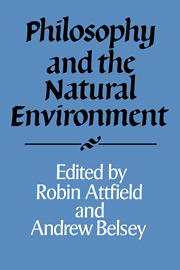Book contents
- Frontmatter
- Contents
- Preface
- Notes on Contributors
- Introduction
- Value in Nature and the Nature of Value
- Ecology and the Ethics of Environmental Restoration
- Rehabilitating Nature and Making Nature Habitable
- Personalistic Organicism: Paradox or Paradigm?
- Values, Reasons and the Environment
- Awe and Humility: Intrinsic Value in Nature. Beyond an Earthbound Environmental Ethics
- The End of Anthropocentrism?
- Global Religion
- Kant and the Moral Considerability of Non-Rational Beings
- The Idea of the Environment
- Chaos and Order, Environment and Anarchy
- Natural Capital
- Some Philosophical Assessments of Environmental Disobedience
- Global Environmental Justice
- Environmental and Medical Bioethics in Late Modernity: Anthony Giddens, Genetic Engineering and the Post-Modern State
- Highlights and Connections
- Bibliography
- Index
Natural Capital
Published online by Cambridge University Press: 19 October 2009
- Frontmatter
- Contents
- Preface
- Notes on Contributors
- Introduction
- Value in Nature and the Nature of Value
- Ecology and the Ethics of Environmental Restoration
- Rehabilitating Nature and Making Nature Habitable
- Personalistic Organicism: Paradox or Paradigm?
- Values, Reasons and the Environment
- Awe and Humility: Intrinsic Value in Nature. Beyond an Earthbound Environmental Ethics
- The End of Anthropocentrism?
- Global Religion
- Kant and the Moral Considerability of Non-Rational Beings
- The Idea of the Environment
- Chaos and Order, Environment and Anarchy
- Natural Capital
- Some Philosophical Assessments of Environmental Disobedience
- Global Environmental Justice
- Environmental and Medical Bioethics in Late Modernity: Anthony Giddens, Genetic Engineering and the Post-Modern State
- Highlights and Connections
- Bibliography
- Index
Summary
Interest in the concept of natural capital stems from the key role which this concept plays in certain attempts to elucidate the goal of sustainable development—a goal which currently preoccupies environmental policy-makers. My purpose in this paper is to examine the viability of what, adapting an expression of Bryan Norton's, may be termed the ‘social scientific approach’ to natural capital (Norton, 1992, p. 97). This approach largely determines the way in which environmental concern is currently being represented in the environmental policy community.
On any account of sustainability—and these are now legion—something or other is supposed to be kept going, or at any rate not allowed to decline, over time. In Blueprint for a Green Economy (Pearce et al., 1989), which I shall treat as epitomizing the social scientific approach, sustainable development (or sustainability—I shall not trouble over the distinction) is construed as requiring that each generation leave its successor a stock of capital assets no less than it receives. In other words, the requirement is that capital—explained also as capital wealth or productive potential—be constant, or at any rate not decline, over time. A distinction is drawn between natural and human-made capital, generating two possible versions of the sustainability requirement, each with variations:
(i) that overall capital—the total comprising both natural and human-made capital—should not decline, or
(ii) that natural capital in particular should not decline (Pearce et al., 1989, p. 34).
- Type
- Chapter
- Information
- Philosophy and the Natural Environment , pp. 169 - 182Publisher: Cambridge University PressPrint publication year: 1994
- 9
- Cited by



